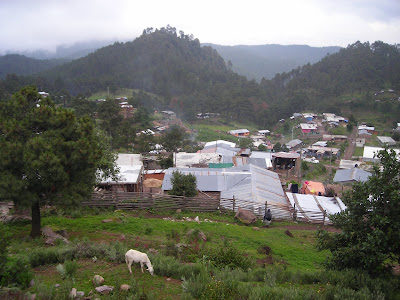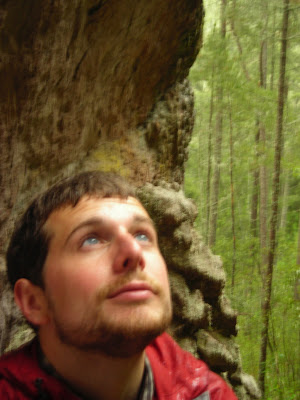
When I come home and think back on a recent journey away, I can measure the value of that adventure in the contact I make with the people who live where I venture. That value is multiplied if I can travel in a way that supports the community I'm visiting and is sustainable to their way of life. While visiting the city of Oaxaca was politically rich and vibrant giving me a glimpse into one family's way of life (primarily taking in foreign students) and beach combing in Mazunte and Puerto Angel was relaxing, the highlight of my trip to Mexico this summer was contained in the last three days of travel in the mountains of the Sierra Norte.

An ecologically rich area of the state of Oaxaca, the people of the Sierra Norte recognized the potential for outsiders to be captivated and educated by their way of life on the land. A grassroots effort to bring people to their villages in a sustainable way is the foundation of the mancomunados. Along the Sierran ridge there are villages, some with as few as 150 people, some with as many as several thousand. In between these villages, are hiking trails that traverse the mountain range and the ecological regions within. In half a day, you can walk from one village to the next. The mancomunado offices are often run by families. Someone is there to greet you and arrange accommodations for you in the nearby cabins and to arrange a guide for you if you wish to walk deeper into the Mexican backcountry.
We arrived our first afternoon in the most-accessible of the mancomunados called Cuajimoloyas. From there, we walked along the road for almost two hours when a lovely couple from the city of Oaxaca offered to give us a lift the rest of the way to Llano Grande. It was only another twenty minutes by car, but with predictable afternoon rain beginning to pelt, we were grateful for the ride. Llano Grande is so small, only 150 residents, that it has only one street. There are two comdeors, which are not exactly restaurants but rather family kitchens where you are welcome to purchase a portion of the family's dinner. For only $26 a night, we had access to a water-sealed cabin with two full beds, showers with hot water, running tap in the sink, and nearby pit toilets.

The view of Cuajimoloyas from the cabins
Inside one of the comedors were a few tables with chairs. Four or five women tended to the calderones of food on the stove in the dim kitchen while they listened to news of the Guelaguetza in nearby but faraway Oaxaca City. A few men sat in the dining area finishing their Coronas. Not sure of the protocol for eating in someone's kitchen, we approached the most authoritative woman and told her in Spanish, "We'd like to eat." She proceeded to pull the lids off the calderones one by one and announce what she could offer us. We were served delicious potato stew, black beans, Oaxacan cheese, homemade tortillas, and deliciously sweet tea reminiscent of the sweet mint tea of Fez, Morocco. The little girl of the house, perhaps eights years olds, happily served us. When we asked her how much the meal cost, even thought we could see and hear her mother not twenty feet from us, the young girl ran to her mother and asked and then ran back to us, our eager messenger. Dinner for two cost only $5.
There was nothing else to do in Llano Grande once the sun set. We settled into our beds before six o'clock that night, sinking into the kind of slumber you can only get when removed from the business of a city and the waking technology of modern life. In the distinct morning we ate breakfast with the only other visitors in town, a couple named Bernat and Olga from Barcelona, one a biologist and one an anthropologist. We caught ourselves up to speed on introductions, interests, reasons for visiting Llano Grande. I got to reminisce on living in Spain and Curt found a shared experience with Olga who had lived in Chile as he had four years ago. Most importantly, the Catalan couple informed us that we still had an hour before our hike began. Unknown to us, the people of the Sierra Norte are not unlike those from Arizona who refuse to take on Daylight Savings Time.

Flowers on the Llano Grande hike, photo by Curt Douglas.
Our seven hour hike that day was lead by our guide Rodrigo, a boy of only twelve years old. He was prepared with his walkie-talkie and backpack with an extra layer of clothes to keep the chill out, water, lunch, and room to collect edible mushrooms for his mother's supper that night. Rodrigo was noticeably shy and understandably so as he was asked to guide four strangers more than twice his age. But, he was a confident guide and one who knew everything about the land we traversed. First of all, it would have been impossible to go on the hike without Rodrigo as we crossed through the backcountry on trails as narrow as deer paths, over barbed wire fences, through livestock pens, and up rocky precipices. Rodrigo never faltered in his mental map of his childhood backyard. And he managed all of our questions gracefully and with acumen. Rodrigo knew the names of all of the flowers, plants, trees, and mushrooms we encountered. I was particularly impressed by Rodrigo because I thought of my students, a few years old than him, who do not live this outdoor experience and so go on a hike with purses or flip flops, ill-equipped without food and water. And then, they whine. Rodrigo happily waited for us if we wished to take photos of the wildflowers or take a break and catch our breath at the high altitude. When we reached the mirador we understood how Rodrigo could be such an expert guide at the age of twelve. There, we crossed paths with his grandfather Rulfino and his group of German visitors from another town. Rulfino had clearly taught his grandson everything he knew about the naturaleza and Rodrigo had taken in this information without a generational grudge, but with respect.

Rulfino and his grandson, our guide, Rodrigo.
The next day we ventured out on a similar trek from Cuajimoloyas. This time our group consisted of a young couple from Italy and another California girl. Our guide was Sonia, perhaps in her late thirties. Sturdy and stout, she wore open-toed plastic shoes, a skirt, and a shawl for protection from the rain. The rest of us were covered in GorTex and REI apparel. No doubt Sonia was the better mountaineer. It rained on us the whole morning of our hike, which lead to some slippery conditions. Most of us feel at some point in the hike. But Sonia could climb to the top of a slippery rock with the agility of a goat and still offer you a hand to ensure you could overcome the precipice too. When I reach for her palm, I felt steadied because her strength extended into my own stance on the earth. With Sonia we were able to see Coyote Canyon and learn about the medicinal uses of many plants.

Sonia
The mancomunados offer more than just guided hikes. Visitors can hire a guide for mountain biking or multi-day excursions. The price of hiring a guide is divided among the group members, which usually means that no one pays more than $10 for a whole day of hiking. Without a doubt, visiting the clean air and the natural beauty of Mexico is a side trip not many people see; life there is built upon gratitude for the earths' gifts and everyone reminds each other to conserve those resources. I am reminded that this is the kind of trip I'd like to encompass the whole of my vacation, not the sidebar.

Curt in Coyote Canyon
Comments
-Jackie